Spinner Fishing For Steelhead: A Complete Guide
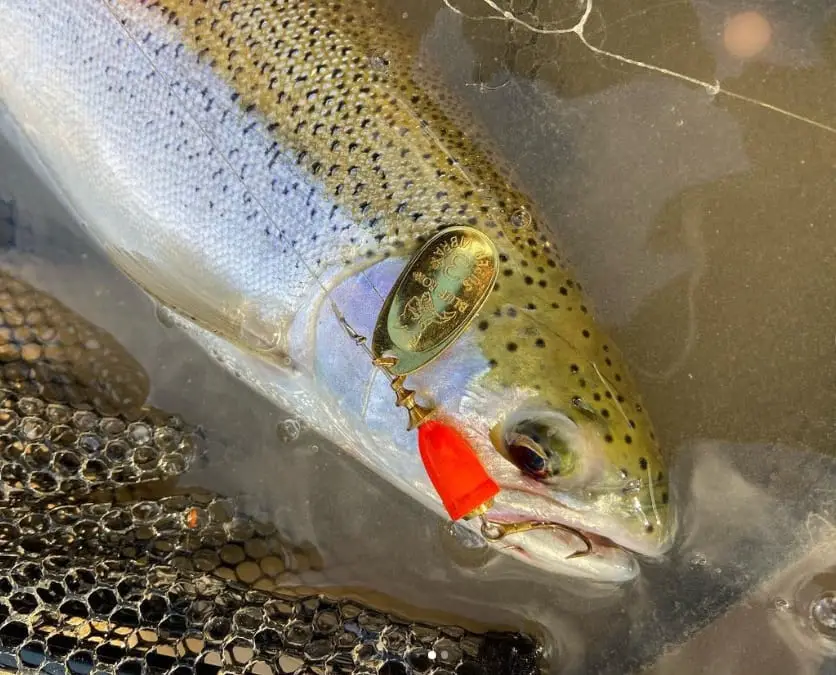
Skilled anglers and guides have great success spinner fishing for steelhead in rivers, off piers, and shorelines, which is a testament to this method. If the top guides are using it, it must be good.
Mastering these proven spinner presentation methods employed by experienced steelhead guides is critical. This is what you should know.
- Spinners: Some spinners are more effective than others due to factors such as vibration, flash, and how they run in currents. I will tell you my favorites and why.
- Size: I will choose and change the size of the spinner based on the conditions.
- Color: I will choose specific colors based on the conditions and will rotate through different colors to determine what the steelhead wants.
- Cover The Water: I systematically cover the entire spot to ensure my clients catch the maximum amount of steelhead from each spot.
- Depth: Understanding the optimal depth for the spinner to be most effective is crucial for successful steelhead fishing with spinners.
- Speed and Angles: I change the retrieve speed based on the conditions, and the mood of the steelhead is good to know.
- Lure Action: There are ways to increase the effectiveness of the spinner. I’ll reveal my secrets to trigger more bites.
Other good fishing guides fish spinners the same way. In fact, I’ve had the opportunity to fish with many guides to learn their tips and tricks, which I will share with you here.
Do Spinners Work for Steelhead?
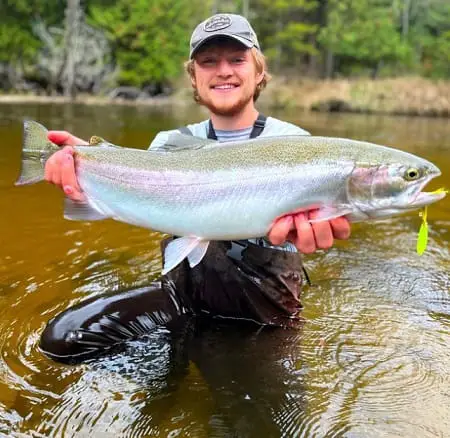
Spinners are highly effective lures for steelhead when used in rivers and when the steelhead are near shore.
Spinners are a widely used lure for anglers and fishing guides across the United States and Canada.
When I guide for steelhead using spinners, my approach depends on various factors such as river conditions, depth, water clarity, current speed, and the activity level of the steelhead.
I believe that choosing the most suitable spinner based on these conditions is also critical.
Steelhead will exhibit aggressive behavior as they migrate up the river for spawning, making them more likely to strike at anything that appears threatening or enters their territory. Well-presented spinners, which resemble baitfish, and vibrate like crazy, are particularly effective in triggering a strike response from steelhead.
Another advantage of using spinners for steelhead is the ability to quickly cover a large area of water and multiple depths.
Now let’s delve into the basics of fishing steelhead with spinners:
Steelhead Spinner Fishing Basics
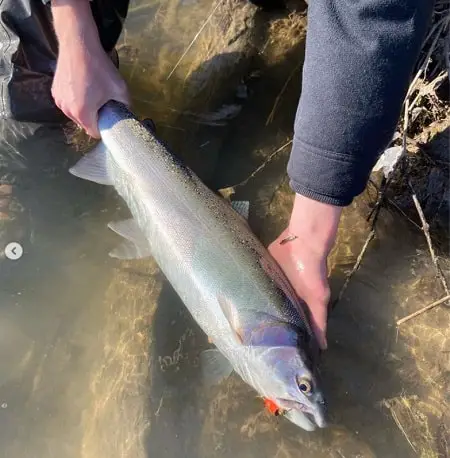
A spinner is a spoon-shaped blade that spins around a shaft with a single or treble hook at the back. It is also known as an in-line spinner.
Few lures can replicate the vibration and flashing of a spinner, which is why they are so effective.
I believe that the vibration can get the steelhead’s attention from a long way, maybe even over 20 feet, while the flash is what triggers a strike once the spinner is close enough to the steelhead.
However, not all spinners are suitable for steelhead, and I find some just work better than others.
Selecting spinners of the right size, color, and weight is crucial. It’s also important to use good quality spinners that won’t fall apart during a battle with a large steelhead. Cheap, no-name spinners suck.
Below, I recommend a range of steelhead spinners that create a captivating flash and vibration in the water, imitating distressed fish. These spinners cast well, and unlike some others, they perform very well in moving water.
Best Spinners for Steelhead Fishing
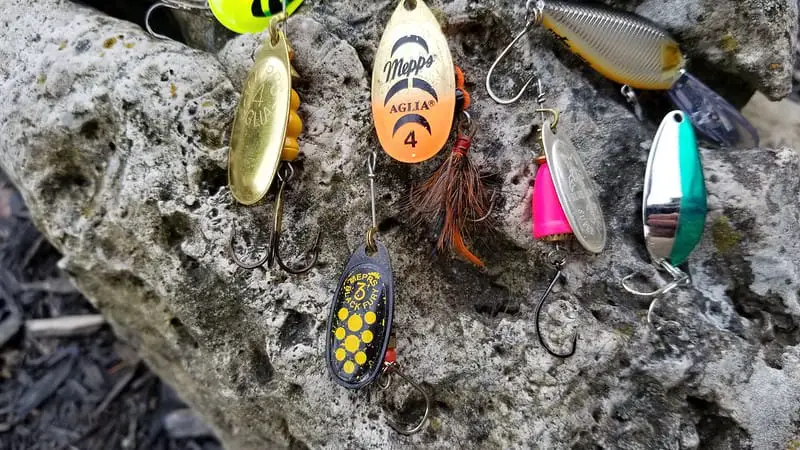
Choosing the correct spinner is essential for achieving success when fishing for steelhead. There are two types of spinners for steelhead, but only one is recommended:
- Long Blade Spinners: These long-blade spinners are designed specifically for faster and deeper retrieves, and they are great for fishing in slower and deeper currents.
- Wide Blade Spinners: Wide blade spinners tend to move slower, they push more water, and they also ride higher in the water column. They are good for shallower water and faster currents.
These wide-blade spinners are the preferred spinners for steelhead fishing, both by myself and other experienced guides.
The optimal length for casting spinners ranges from 2 to 4 inches, which closely matches the size of most baitfish in the river or the ones steelhead have been feeding on in the ocean.
A length of 3 to 4 inches is generally ideal for large steelhead in most water conditions, providing a large enough target to attract the attention of steelhead.
As a general rule, use larger spinners in turbid or high-flow conditions and in dirtier water, and use smaller spinners in clear water or when targeting cautious fish holding in pools.
Below are some of my most effective spinners for steelhead fishing in rivers:
- Mepps Aglia: The Mepps Spinner line is widely regarded as one of the most popular spinners for steelhead. Mepps spinners perform exceptionally well in rivers and are suitable for casting off piers or shorelines. The 3-inch size # 3 and #4 blades are my go-to size for fishing larger water bodies and big steelhead. This size allows for long casts.
- Blue Fox Vibrax: The Blue Fox Vibrax spinners are my favorite and most used spinner for steelhead. Based on my tests, they have more vibration than all other spinners, and for me, that usually means more steelhead in the net. This is always my go-to spinner in higher or dirtier water. The 3-inch length is good, and blade sizes #3, #4, and #5 are great for big fish.
- Panther Martin Spinners: The 3-inch size of this spinner is popular and is effective for steelhead. It works excellently in rivers and is also suitable for pier fishing.
- Blue Fox Vibrax Bullet: This spinner is meant for deeper water and faster retrieves. It is highly rated and known for its reliability when fishing for steelhead.
- Mepps Flashabou Spinner: I love the tail action and flash of this spinner. At times, this spinner works well in rivers when other spinners don’t seem to work well, especially when targeting larger and faster steelhead. It is particularly effective in bigger and swifter rivers.
Check out more of my best spinners and other lures for steelhead.
Choosing the Best Spinner Colors for Steelhead

The color of the spinner can significantly influence the steelhead’s interest and likelihood of biting, but the most effective color will depend on the steelhead’s mood and the water clarity, as well as light conditions.
Silver, gold, or brightly colored spinners with reflective surfaces tend to be the most effective, as they create a flash that can be seen from a distance.
Under specific conditions, I have done very well with black spinners or black/silver combinations. Mepps Black Furrys and Patrher Martins come in black colors.
Based on my experience, the most consistent spinner colors for steelhead fishing in rivers are chartreuse, chartreuse/silver, silver, silver/orange, green/silver, and blue/silver.
Effective Techniques for Steelhead Spinner Fishing
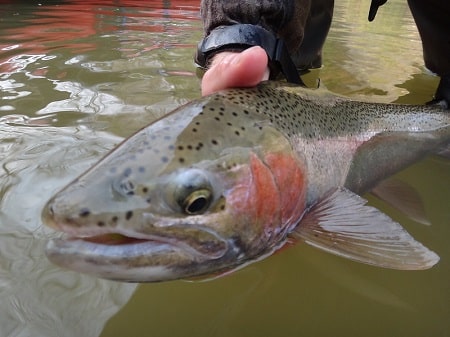
There are three effective techniques for spinner fishing for steelhead:
Method #1: The most commonly used technique involves casting the spinner into the river and retrieving it straight with a slow and steady motion.
Depending on the depth and speed of the river, you may need to let the spinner sink for a bit or adjust its depth accordingly.
I will discuss depth and water columns in more detail later on.
To make this method slightly more effective, I like to rip or twitch this lure every 5 to 10 feet to make it look more like an injured or dying baitfish. This more erratic retrieve tends to double the amount of steelhead I catch.
Method #2: This technique works best in faster currents. Cast the spinner across and slightly downriver, allowing the current to carry the lure across the pool without any reeling. This “swing” technique moves the spinner downstream and across as it sinks, vibrates, and entices the steelhead to strike.
Method #3: With this method, I cast the spinner out and across the river, allowing it to sink to the bottom. I lift the rod tip from waist high to a few feet over your head, then lower the rod and repeat. When lifting the rod tip, I want to do it quickly to spin the blades. This creates an up-and-down jigging motion, simulating an injured baitfish.
The fluttering action of the spinner on the drop can trigger an aggressive response from steelhead. This jigging method is particularly effective in areas where steelhead gather, such as beneath waterfalls or behind large obstacles in the river, as well as in pocket water.
Determining the Retrieval Speed For Spinners
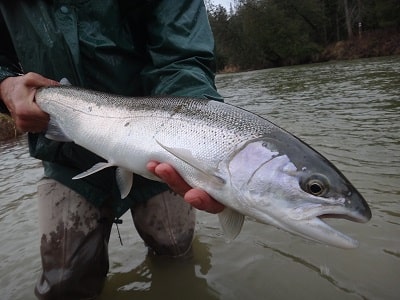
The speed at which you reel in the spinner depends on its action, your reel speed, and the current’s velocity.
The blade needs to spin, which is usually only achieved at a certain speed. If it is pulled too slow, it won’t spin quickly, which won’t create a lot of vibrations.
I recommend my clients retrieve the spinner at an appropriate speed that enables the steelhead to hear or feel it, see it, and grab it, which means ranging from a slow to medium speed.
However, some spinners can be retrieved faster to cover more water, and agressive steelhead will still grab it.
If the spinner starts popping out of the water’s surface, it indicates that you are reeling too fast or your rod tip is too high.
Try to maintain a steady speed, and if the current is faster in the middle of the river, slow down your reeling speed to match the current’s pace. The current alone will spin the blades. In very swift currents, you may not need to reel at all and can simply allow the lure to swing across the river.
It’s important to note that the faster you reel the spinner, the higher it will remain in the water column. This may not be ideal for catching steelhead that are holding deep and are reluctant to come up for a lure.
Determining the Optimal Depth for Spinner Fishing
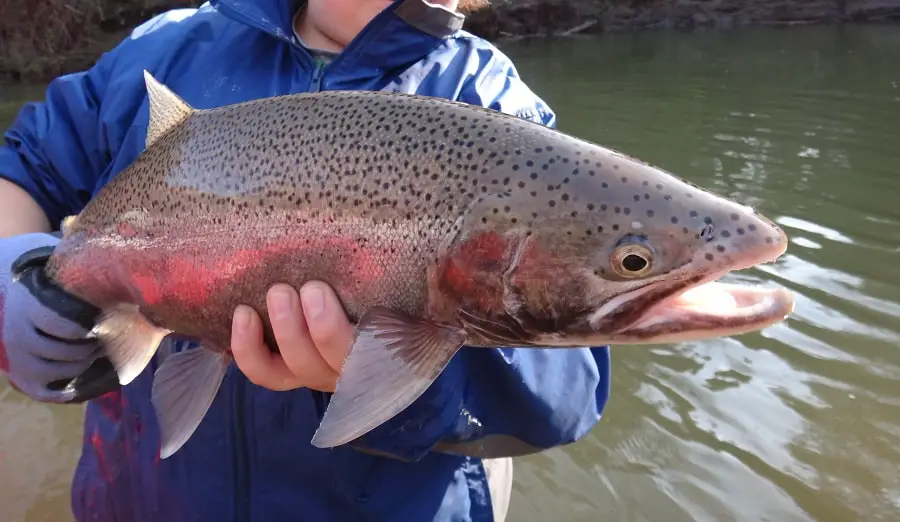
Although steelhead are often found close to the riverbed, it doesn’t necessarily mean that your spinner should be at the same depth.
To determine the right depth for your spinner, aim for approximately 2 to 3 feet above the steelhead’s position. In clear water, you can get away with the spinner 5 to 6 feet above the fish, but closer is almost always better.
When steelhead fishing with spinners, the goal is to keep the spinner in the strike zone of the steelhead.
Since steelhead prefer to feed upward, it’s important to keep the spinner off the bottom and above their heads. Avoid dragging the spinner along the riverbed, as this can lead to snags and reduce its effectiveness.
In my opinion, getting your spinner closer to the steelhead increases the likelihood of provoking a strike. However, determining the precise depth requires strategic tactics, which I’ll discuss below.
Fishing High and Low in the Water Column
When fishing for steelhead with spinners, there are two approaches to positioning the lure in the water column. Most of the time, steelhead will be near the bottom, but there are instances when they may be suspended at a higher level. Let’s explore both approaches:
Fishing Spinners High for Steelhead
In shallower rivers or areas less than 6 feet deep, you can begin reeling as soon as the spinner hits the water, this will keep the spinner high in the water column.
Sometimes, the spinner may be only a foot or two below the surface, which can be sufficient if the area is 5 feet deep or less. In shallow water, you may also need to hold your rod tip high to keep the spinner elevated, off the bottom, and within the steelhead’s striking zone.
The elevation of your rod tip depends on factors such as current speed, spinner weight, and the depth of the water. If you find that the spinner is hitting the bottom with a waist-high rod tip, raise the rod tip to about head height to get a higher presentation.
If the spinner still bumps the bottom, lift the rod tip even higher. From my experience, it is rare that I need to lift the rod tip above my head.
Fishing Spinners Deep for Steelhead
To achieve greater depth, cast straight across or even slightly upriver, allowing the spinner to sink before starting the retrieve. The longer you wait before retrieving, the deeper the spinner will sink. While reeling in, the spinner may start to rise, but a slower retrieval speed will help maintain its depth.
Keeping the rod tip low will also prevent the spinner from rising too quickly.
Sometimes, I will even submerge the rod tip below the water’s surface to maximize depth and prevent the spinner from rising. If you notice that the spinner consistently hits the bottom, it indicates that you are fishing too deep.
A tip I give to my clients is to let the spinner completely sink, and once you believe it’s on the bottom, lift the rod tip abruptly about three feet and start reeling at a slow to medium speed with your rod tip waist high. This usually gets your spinner about 3 to 4 feet off the bottom, which is usually a perfect depth.
Covering All Depths of the Water Column
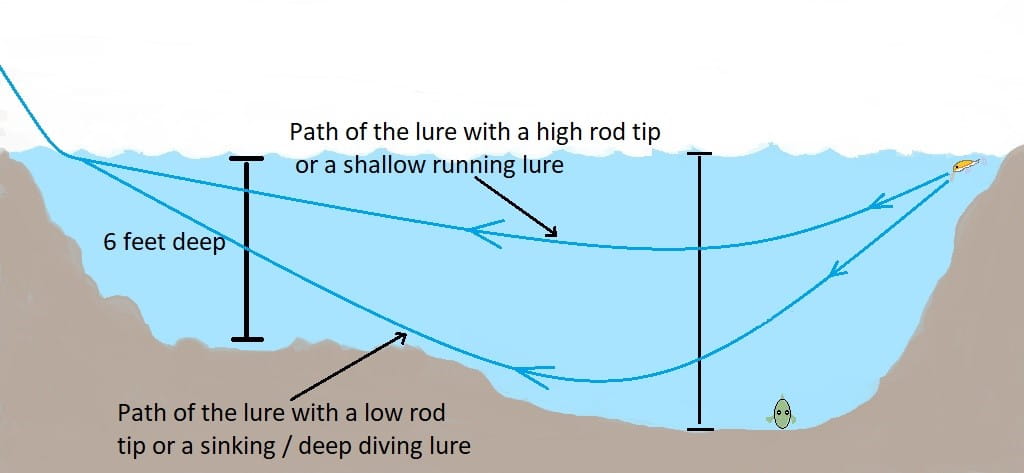
Now that you understand how to keep the spinner high or low, let’s discuss how to determine the appropriate depth for your spinner.
Many anglers cast out and reel in without knowing the depth of their spinner or the position of the fish. Meaning, they don’t have a clue how deep the river is, and they have no idea if the steelhead or the lure is 20 feet down, or 6 feet down.
They end up guessing where their spinner is and where the steelhead and the result is often a lot of missed fish.
To optimize your chances of success, try my systematic approach to finding the steelhead. Here’s my method for covering all depths of the water column:
First Cast: Start by covering the top part of the water column with your first cast. Begin reeling immediately and slowly to keep the spinner near the surface.
Second Cast: Repeat the cast, aiming to land the spinner in the exact same spot as the previous cast. This time, allow the spinner to sink three to six feet, or three to six seconds, lowering your rod tip to the water’s surface or just below it. This enables you to effectively target the middle or lower part of the water column.
Third Cast: If you haven’t hit a fish or hit the bottom on the first two casts, cast back to the exact same spot and let the spinner sink even deeper or all the way to the bottom before initiating the retrieval. Once it reaches the bottom, lift the rod tip 3 to 6 feet to suspend the spinner 3 to 6 feet above the riverbed.
Repeat: Once you are sure you are near the river bottom, cast 3 to 5 feet downstream from your previous cast and repeat the process. Pay close attention to any bites or bumps you receive on any of the three casts. These signs can indicate the depth at which the fish are actively feeding or holding.
Once you find that depth, whether it be the first, second, or third cast, each cast after you can only focus on that depth. This allows me to eliminate the first or second cast and cover the pool more efficiently and faster.
I prefer this methodical approach to discovering the fish’s location rather than rapidly covering a large area and hoping my spinner is near the fish.
Casting Direction For Maximum Efficiency
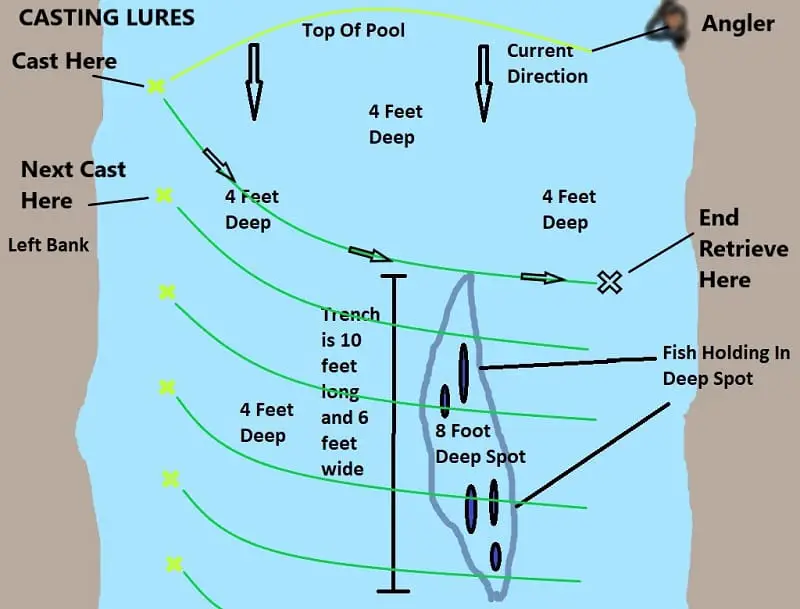
When casting a spinner, I have found that casting straight across the river or slightly downriver tends to yield the best results.
Although some anglers prefer to cast upriver and retrieve the spinner downstream, my experience suggests that casting straight across is much more effective.
Casting a spinner upriver may allow it to sink deeper, but presenting the spinner to the steelhead head-on can startle the fish or make it more challenging for them to strike. It can also prevent the blades from spinning since the downward current removes the pressure that is required to spin the blades.
On the other hand, a spinner swinging sideways and moving across the fish’s field of view presents an easier and more enticing target. Therefore, an across-river cast with a sideways retrieve is generally the preferred method.
Effective Coverage Of The Water
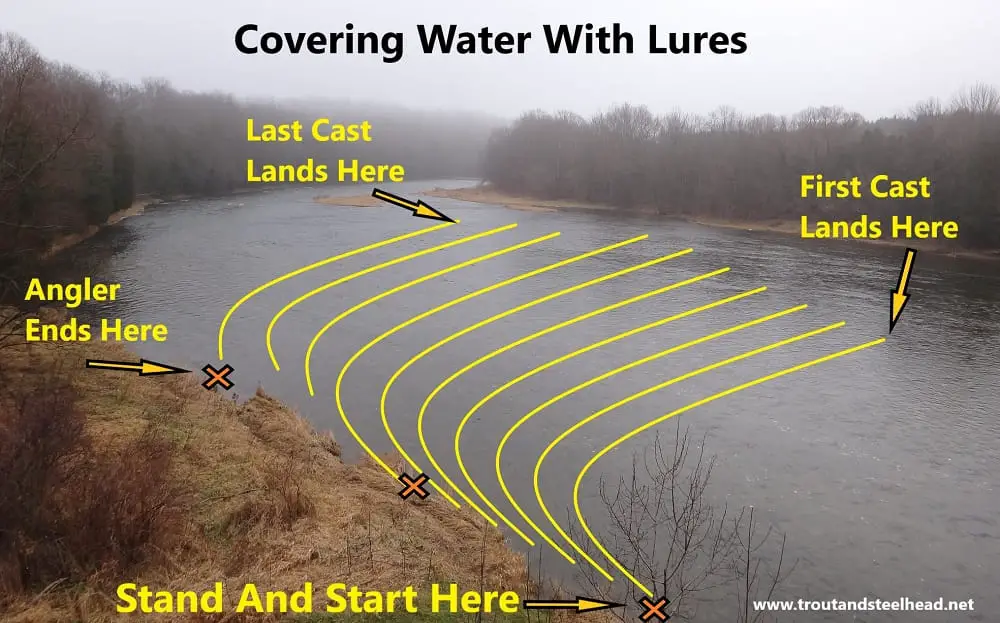
Effectively covering the water is crucial when using spinners for steelhead fishing.
Instead of randomly casting in all directions, it’s best to methodically cover the water from top to bottom.
Casting randomly and not covering the water is a common issue I’ve observed among anglers and is one of the reasons why they often struggle to catch fish.
I recommend starting your first retrieve at the very top of the fishing spot and gradually moving your retrieval down 3 to 5 feet with each consecutive cast.
This approach ensures that every fish in the area has a chance to see and strike at the spinner, leaving no gaps in coverage.
Understanding and implementing this systematic coverage technique sets you apart from anglers who cast aimlessly and miss potential opportunities.
Adjusting To River Conditions When Spinner Fishing
Having a good understanding of river conditions is essential for adapting your fishing tactics. Factors such as water depth, current speed, water clarity, the presence of structures like rocks and logs, and the width of the river all influence steelhead behavior and should guide your approach.
It’s important to remain flexible and adjust your strategies accordingly. Let’s consider a few scenarios:
Clear Water Spinner Fishing
In clear water conditions, you have the advantage of running your spinner up to 6 feet away from a steelhead and still potentially getting bites.
Silver and brightly colored spinners with reflective surfaces work well in these conditions, as they create a visible flash. A slightly faster retrieval can be effective since the steelhead can spot the lure from a greater distance and have more time to react.
However, in shallow and clear water, steelhead can be easily spooked by the splash of the spinner or its proximity. To overcome this, consider using smaller and less flashy spinners.
Also, try to cast them farther away from the fish and retrieve them at a slower pace to try not to spook them. Things zipping fast through a pool is not normal, and anything that is deemed out of the ordinary can spook steelhead.
Avoid landing the spinner directly on top of the fish or in the middle of the pool. Instead, aim to get it as close to the far bank as possible and pull the spinner in front and past the fish. Spinner and other lures coming up behind the fish can also spook them.
Dirty or Stained Water Spinner Fishing
When fishing in dirtier water or water with reduced clarity, it becomes crucial to get the spinner closer to the steelhead, within a foot or two if possible. Slow down your retrieval speed to accommodate the reduced visibility.
The jigging retrieve method is particularly effective in these conditions, as it allows the steelhead to locate and strike at the spinner even when visibility is poor.
In very muddy water, I recommend switching to the noisiest spinner or even switching to a crankbait with a rattle. The added noise helps the steelhead locate and strike at the lure when they can’t rely on sight alone.
In such conditions, I prefer larger spinners and bright chartreuse colors, as they provide better visibility.
Fast and Slow Water Spinner Fishing
In faster currents, opt for the swing method. Cast the spinner across the river and allow the current to carry it downstream, mimicking the movement of a baitfish.
Avoid reeling too quickly, as it can cause the spinner to spin out or become too fast for the fish to detect and strike.
On the other hand, in slower water, a slow to medium-speed retrieval or a jigging retrieve works best. The swing method is less effective in these conditions, as a slow current doesn’t provide enough speed to spin the blades of the spinner and may cause the spinner to hit and drag along the riverbed.
Tight Lines
Graham
